The Rise and Fall of Supersymmetry
It was the most promising idea for where new physics might lie. Now that the LHC data is in, is it dead?
“The revolution is not an apple that falls when it is ripe. You have to make it fall.” –Che Guevara
Over the past 100 years, our picture of the Universe has changed dramatically, on both the largest scales and the smallest.

On the large-scales, we’ve gone from a Newtonian Universe of unknown age populated only by the stars and nebulae in our own Milky Way to a Universe governed by General Relativity, containing hundreds of billions of galaxies.
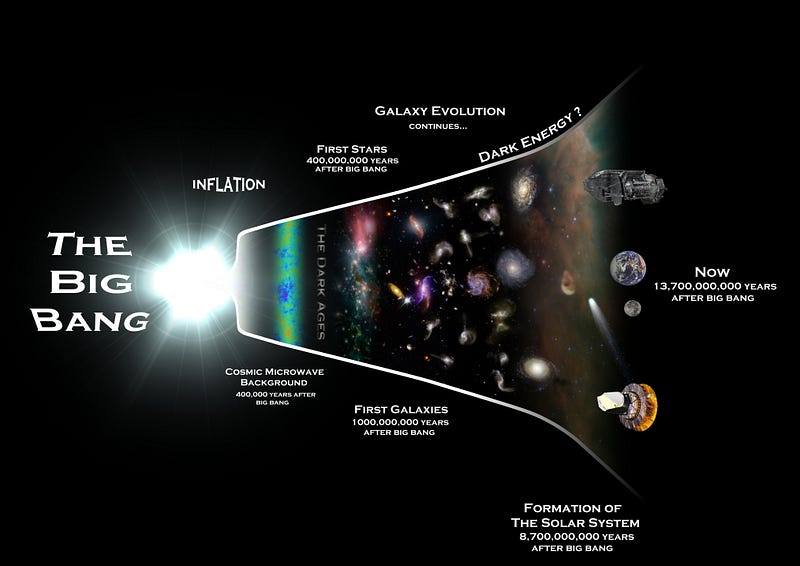
The age of this Universe is dated at 13.8 billion years since the Big Bang, the observable part of which is some 92 billion light-years in diameter, filled with normal matter (and not antimatter), dark matter, and dark energy.
And on the small scales, the revolution has been just as dramatic.
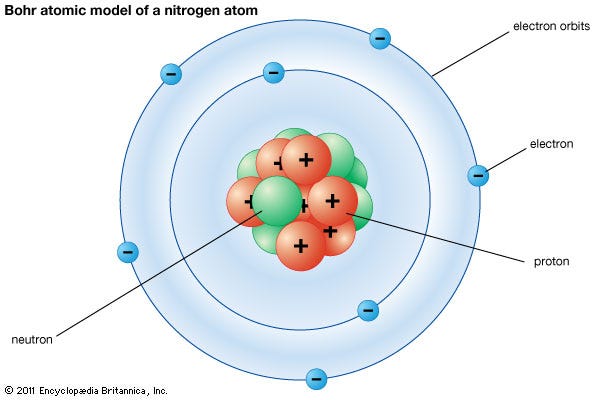
We’ve gone from a Universe made up of atomic nuclei, electrons and photons, where the only known forces were gravitational and electromagnetic, to a much more fundamental understanding of the smallest particles and interactions that make up the Universe.
Nuclei are made up of protons and neutrons, which — in turn — are made up of quarks and gluons. There are two types of nuclear forces, the strong and the weak forces, and three generations of particles, including the leptons (electrons, neutrinos, and their heavier counterparts) and quarks (up, down, and their heavier counterparts). There are gauge bosons governing the strong, weak, and electromagnetic forces, and finally there’s the Higgs, bringing this all together under the framework of the Standard Model.

And combining the Standard Model of particle physics with General Relativity and the standard model of modern cosmology means that we can nearly explain the entire physical Universe! By beginning with a Universe that had slightly more matter than antimatter, and starting just some 10^-10 seconds after the Big Bang, we can account for all of the observed phenomena using only the already-established laws of physics. We can reproduce — with simulations — a Universe that is, in all meaningful ways, physically indistinguishable from our own.
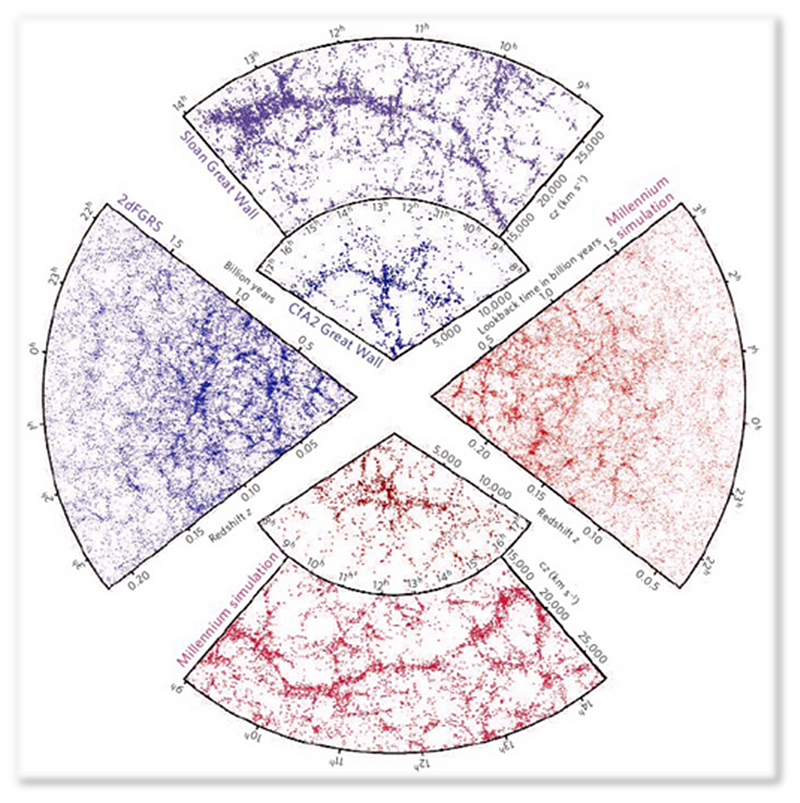
And yet, there are some very fundamental questions we still don’t understand. Among them are:
- Why is there more matter than antimatter? Where did the asymmetry (of the observed magnitude) come from?
- What is the nature of dark energy? What is the field/property responsible for it?
- What is the nature of dark matter? What is the particle responsible for it?
- We know that, at very high energies, the electromagnetic and the weak force unify, and are actually a manifestation of the electroweak force, whose symmetry is broken at low energies. Do the other forces — the strong force and maybe even gravity — unify at some even higher energy?
- And finally, why do the fundamental particles — the ones in the Standard Model — have the masses that they do?
This last one is a problem known as the hierarchy problem in physics, and it goes something like this.
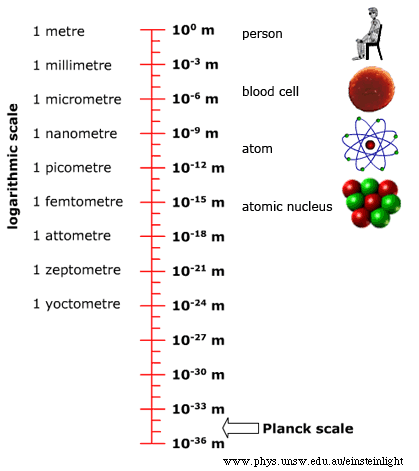
There are a few fundamental constants in nature: the gravitational constant (G), Planck’s constant (h or ħ, which is h/2π), and the speed of light (c). There are different combinations of these constants we can create to get values for time, length, and mass; these are known as Planck units.
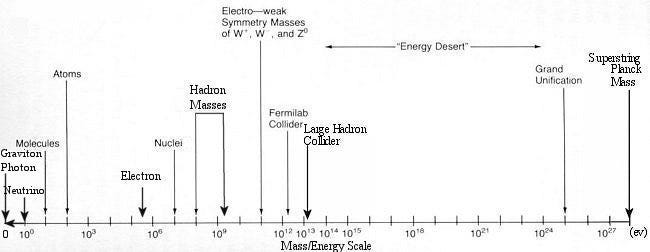
If you were to predict the mass of the particles in the Standard Model from first principles, they ought to be on the order of the Planck mass, which has an energy of around 10^28 eV. The major problem is that this mass is 17 orders of magnitude, or a factor of 100,000,000,000,000,000 larger than the heaviest observed particle in the Universe. The Higgs boson, in particular, should have the Planck mass, and — since the Higgs field couples to the other particles, giving them mass — so should all the others.

Yet, we’ve found the Higgs boson, and its mass is only 1.25 × 10^11 eV, a far cry from the 10^28 eV we’d have naïvely expected.
So why, we ask, do the particles have the mass that they do, and not much, much larger ones? The best, most elegant solution is that there’s an extra symmetry that cancels out all those Planck-scale contributions, and protects the mass down to a much lower energy.
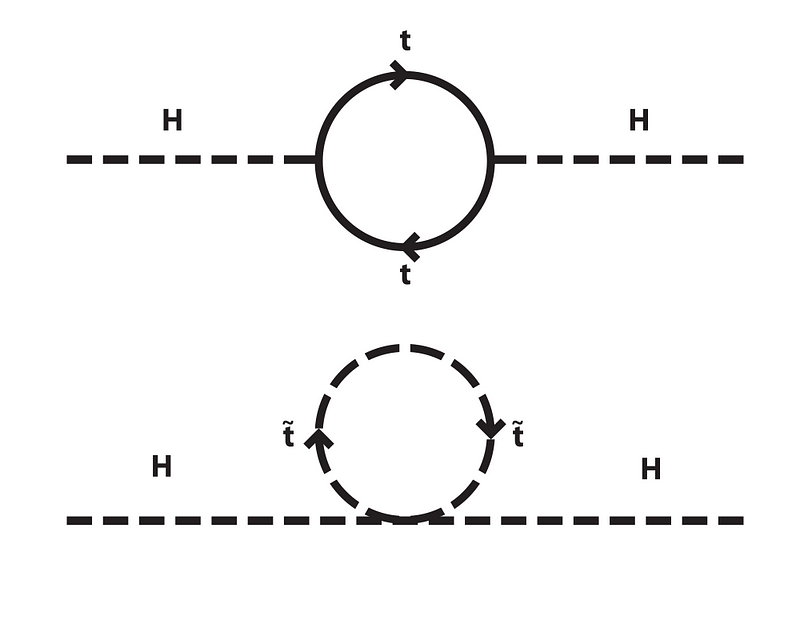
That’s the idea behind Supersymmetry, known as SUSY for short. Supersymmetry makes the very bold prediction that every one of the Standard Model particles has a partner particle — a superpartner — that has nearly identical properties, except has a spin that’s different by a value of ±½ from its Standard Model counterpart.
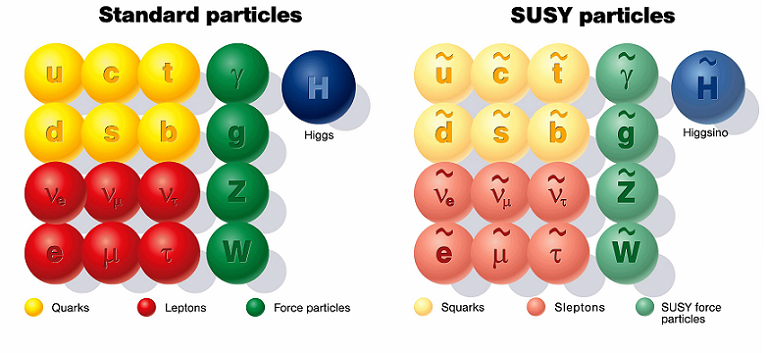
Every fermion (like quarks and leptons) should have a boson superpartner (squarks and sleptons), and every boson (like the photons and gluons) should have fermionic superpartners (photinos and gluinos).
These superpartners should protect the mass of all the particles — the Standard Model ones and the SUSY ones — all the way down to the scale at which SUSY is broken, at which point the superpartners acquire a heavier mass than the normal ones.
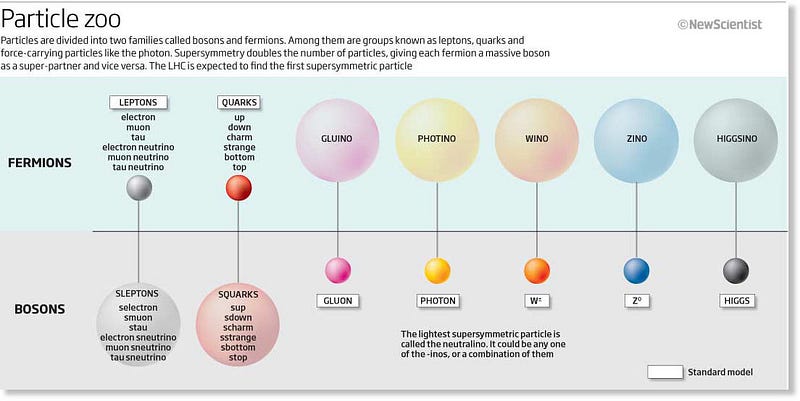
If SUSY is broken at the right scale to solve the hierarchy problem — somewhere between 100 GeV and 1 TeV, where the heaviest standard model particles live — then the lightest supersymmetric particles should be accessible by the LHC.
But there’s more.
There are a bunch of things that are known not to happen in the Standard Model to very high precision: baryon number isn’t violated, lepton number isn’t violated, and there are no flavor-changing neutral currents. In order to make these things also not happen in SUSY, you need a new symmetry called R-parity, which comes along with an added feature. If R-parity is real and SUSY is real, then the lightest supersymmetric particle is stable, which means, if enough of them are left over from the hot Big Bang, it could be the dark matter!

There’s even one more cool thing that happens: if you take all the particles in the standard model, and you look at the interaction strength of the three forces, you’ll find that the strength of the forces — parametrized by their coupling constants — changes with energy. They change in such as way that, in the Standard Model, they almost meet at some high energy (around 10^15 GeV), but just miss, slightly, if you put them on a log-log scale. But if you add in supersymmetry, the addition of these new particles changes the way the coupling constants evolve. And therefore, if SUSY is right, it could indicate a place where the electromagnetic, weak and strong forces all unify at a high energy!

In other words, there are three major problems that could all be solved by the existence of supersymmetry; it’s a great idea! (There are four if you count the problem of the Coleman-Mandula theorem, which many do.)
But there’s also a few problems with each of these three problems that SUSY looks like it solves:
- If it solves the hierarchy problem, then there should definitely be new supersymmetric particles discovered at the LHC. In pretty much all models of supersymmetry, they should have already been discovered by now. In fact, if the LHC does not discover supersymmetric particles, then even if SUSY exists, there must be some other solution to the hierarchy problem, because SUSY alone won’t do it.
- If the lightest supersymmetric particle is, in fact, the dark matter in the Universe, then experiments designed to see it, such as CDMS and XENON, ought to have seen it by now. In addition, SUSY dark matter should annihilate in a very particular way, which we haven’t seen. The null-detection status of these experiments (among others) is a big red flag against this. Plus, there are plenty of other good dark matter candidates as far as astrophysics is concerned; SUSY is hardly the only horse in the race.
- The strong force may not unify with the other forces! There’s no reason, other than our predisposition towards liking more symmetric things, for that to be the case. There’s also the issue that if you put any three curves on a log-log scale and zoom out far enough, they will always look like a triangle where the three lines “just barely” miss coming together to a point.
But the biggest failures of SUSY are not theoretical ones; they’re experimental.
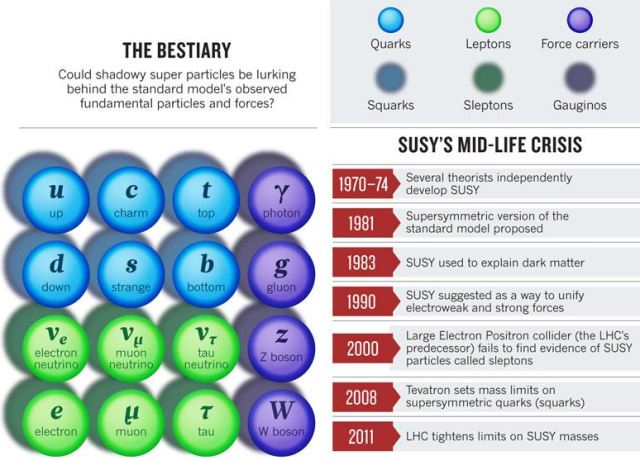
And there are a lot of different ways of representing just how difficult it is to reconcile what SUSY expects with what we actually have — and haven’t — seen.

At the LHC, supersymmetric particles should have been detected by now, if they exist. There are plenty of theorists and experimentalists who are still optimistic about SUSY, but nearly all models that successfully solve the hierarchy problem have been ruled out.
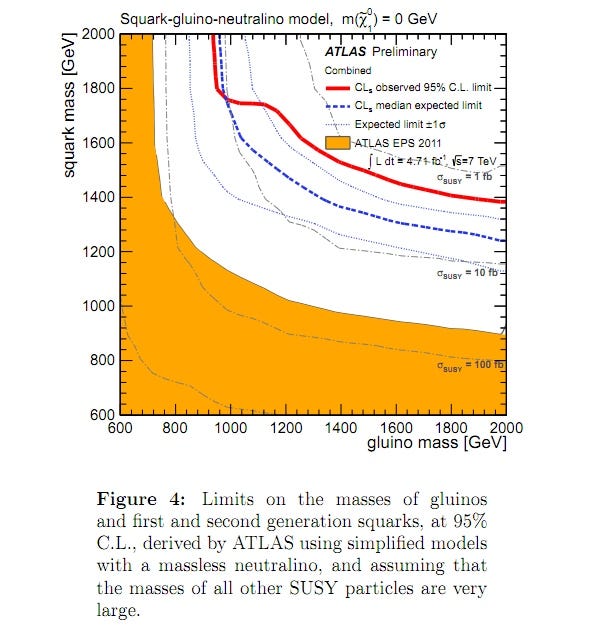
At this point in the game, based on what we’ve seen (and haven’t seen, like any non-standard model particles) so far, it would be shocking if the LHC actually did turn up statistically meaningful evidence for supersymmetry. As always, continued experimentation will be the ultimate arbiter of nature, but I think it’s fair to say that the only reason SUSY gets as much positive press as it does is for two simple reasons.
- A lot of people have invested their entire careers in SUSY, and if it’s not a part of nature, then a lot of what they’ve invested in is nothing more than a blind alley. For example, if there is no SUSY in nature, at any energy scale (including the Planck Scale, although this will be a challenge to test), then string theory cannot describe our Universe. Plain and simple.
- There are no other good solutions to the hierarchy problem that are as satisfying as SUSY. If there’s no SUSY, then we have to admit that we have no idea why the masses of the standard model particles have the value that they do.
Which is to say, SUSY or not, physics is still going to have a lot of explaining to do, and there’s plenty of work to be done if our goal is to understand the Universe. But the biggest problem is that SUSY predicts new particles, and it predicts their existence — at least, of the lowest-mass ones — to occur in a fairly specific range of energies.
And we’ve probed those energies at the LHC, and seen nothing so far.
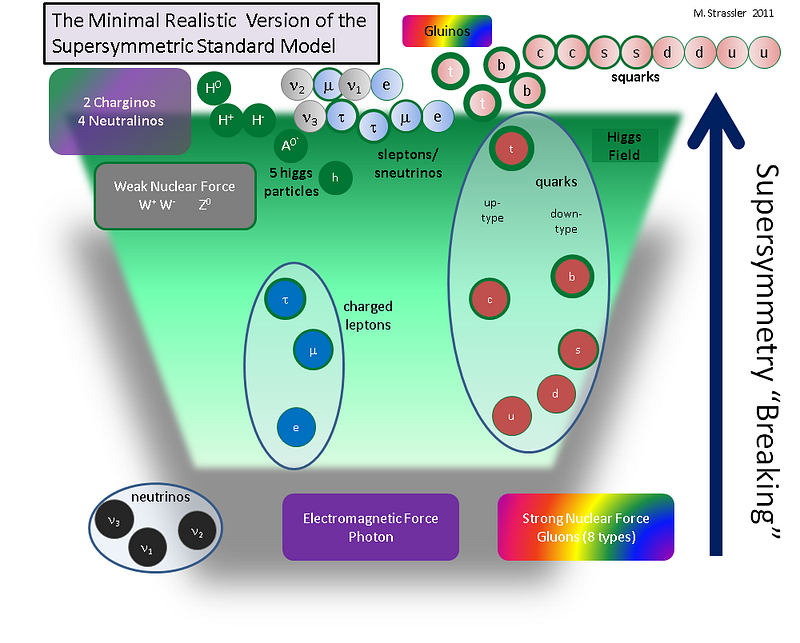
If you want SUSY to solve the hierarchy problem, you can invoke any number of models to do it (including the MSSM, split SUSY, NMSSM, CMSSM, or NUMH1, among others), but they all have one feature in common: at least one new particle not in the standard model at energies under 1 TeV, accessible via colliders. The Large Hadron Collider should have seen such a thing (if it existed) by now, and should definitely see it (if it exists) when its upgraded run takes place beginning next year.
If the new particles aren’t there, then this isn’t the right story. No matter how many problems it would solve, no matter how beautiful it would be, no matter how much we’ve invested in it, the experimental results are the ultimate arbiter of nature. At this point, the theoretical hoops being jumped through to keep SUSY “viable” (and yes, that belongs in air quotes) given our null results are getting progressively more and more extravagant. I’m not much of a betting man, but if I were, I’d say that SUSY — at least the variant of it that solves the theoretical problems our Universe raises — is already dead. It’s just waiting for the coffin nails to be hammered in.
An earlier version of this post originally appeared on the old Starts With A Bang blog at Scienceblogs.





